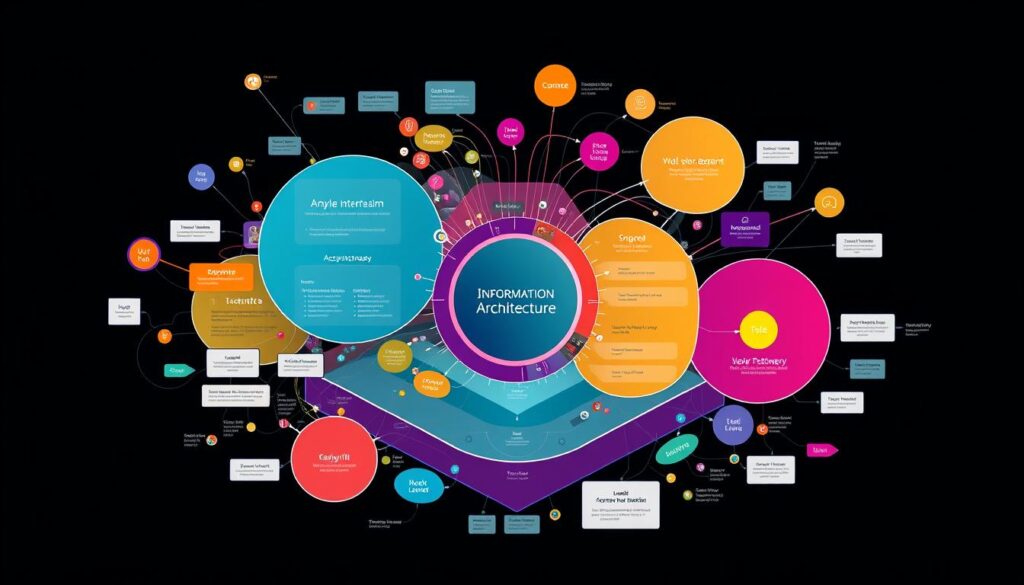I’ve always been fascinated by the power of well-crafted user interfaces and experiences. A well-designed product can captivate and delight users. It makes complex tasks easy to navigate. But what makes these designs so effective?
In this guide, I’ll share the essential principles of UI/UX design. You’ll learn how to improve your own designs.

Throughout my career, I’ve worked with top designers. Each has their own approach and insights. They’ve taught me that UI/UX design is more than just looks. It’s about understanding user needs, technical limits, and human behavior.
By mastering these principles, you’ll create experiences that captivate and inspire.
Key Takeaways
- Discover the fundamental principles of effective UI/UX design
- Understand the core elements that shape successful user interfaces and experiences
- Learn how to balance aesthetics, functionality, and user-centered design
- Explore the latest trends and best practices in the world of digital design
- Gain insights from industry experts to elevate your own design skills
Understanding the Core Principles of Design
In the world of visual design, interaction design, and human-computer interaction, key principles are essential. They help create amazing digital experiences. Let’s explore the main ideas that make interface design effective.
Balance and Visual Hierarchy
Creating a balanced digital space is key. Designers use symmetry, asymmetry, and visual weight to guide the user’s eye. A clear visual hierarchy is also vital. It makes sure the most important parts are easy to find and use.
Color Theory and Typography Basics
Color can make users feel certain ways and show off a brand’s identity. Knowing color theory helps designers make interfaces that look good and are easy to use. Choosing the right typography also improves the user’s experience, making things easier to read and look at.
Gestalt Psychology in Design
Gestalt psychology, with its principles like proximity and similarity, is crucial. It helps designers understand how people see and interact with digital spaces. By using these ideas, designers can make interfaces that are easy to use and feel right to users.
Using these design principles is the first step to making great digital interfaces. As we learn more about UI/UX, these ideas will guide us. They help mix visual design, interaction design, and human-computer interaction smoothly.
UI UX Fundamentals: Building Blocks for Success
Making user interfaces that capture attention and providing great user experiences is key to digital product success. If you’re looking to become a UX UI learn pro, knowing the basics of UX and UI design is vital.
Understanding layout principles is at the core of any top-notch user interface. It’s about where elements are placed and how easy it is to navigate. A well-designed UI UX trends starts with careful planning of space. Designers use visual hierarchy to make sure users can move through the interface smoothly and easily.
Interactive design patterns are also essential. They add life to digital interfaces with things like icons and micro-interactions. These elements make the interface engaging and fun, improving the UX for users.
As the world of UX UI learns grows, keeping up with new UI UX trends is important. Trends like voice-activated interfaces and more focus on accessibility are changing the design scene. These changes offer both challenges and chances for those who love creating great user experiences.
“Great user experience is not about the latest design trends or technologies, but about understanding and meeting the needs of your users.”
By learning the basics of UX and UI design, you can set yourself up for success in the digital world. From understanding layout to creating interactive elements, the secret to amazing user experiences is knowing the core principles of the industry.

The Role of User Research and Information Architecture
Creating a great user interface (UI) and user experience (UX) starts with knowing your audience. User research and information architecture (IA) are key here. They help you understand your users well, leading to better user personas, flows, and content strategies.
User Persona Development
User personas are essential in design. They are like models of your ideal users. By studying their demographics, goals, and challenges, you can design experiences that meet their needs. A good persona guides your design and development choices.
Creating Effective User Flows
Understanding your users leads to mapping their journey through your product. User flows show how users reach their goals, pointing out where they might get stuck. Designing smooth user flows boosts engagement and conversion rates.
Content Strategy and Structure
Content organization is vital for a good user experience. Information architecture (IA) makes content easy to find and use. Good IA boosts user satisfaction and helps your product or service stand out, aligning with your information architecture and user experience design course goals.
| User Research Technique | Key Insights Gained |
|---|---|
| Interviews | User pain points, motivations, and behaviors |
| Usability Testing | Feedback on product/service usability and user flow |
| Contextual Inquiry | Understanding users’ natural environment and workflows |
| Surveys | Quantitative data on user preferences and satisfaction |
By combining user research and information architecture in your product design course, you can make experiences that connect with your audience and help your business grow.

Mastering Interactive Design Patterns
In the world of UI and UX design, knowing interactive design patterns is key. It helps make digital experiences engaging and easy to use. As we look at the UI/UX trends of 2025, learning these patterns can boost interaction design and usability.
Micro-interactions are a big deal now. They are small animations or changes that happen when you click a button or update content. These tiny interactions make the interface more fun and give users clear feedback.
- Seamless micro-interactions that enhance the user experience
- Responsive design patterns that adapt to various device sizes and platforms
- Intuitive gestures and touch-based interactions for mobile and tablet users
- Personalized recommendations and content suggestions to improve user engagement
Looking to 2025, designers and developers need to meet user needs. New tech like AR and VR is bringing fresh design ideas. By keeping up with trends and testing designs, they can make sure their work stays engaging and useful.
“The essence of interaction design is to create experiences that make the complex simple and the simple elegant.”
Prototyping and Usability Testing Methods
Creating great user experiences starts with understanding prototyping and usability testing. These key design thinking tools help us make our interfaces better. They ensure our designs meet our audience’s needs.
Low-Fidelity vs. High-Fidelity Prototypes
Prototyping can range from simple sketches to detailed digital models. Low-fidelity prototypes, like hand-drawn wireframes, are fast and cheap. They’re perfect for early ideas and checking if they work. High-fidelity prototypes, which look like the real thing, are great for testing specific design parts and how users move through them.
User Testing Best Practices
Usability testing is key for any design project. Watching users interact with our prototypes helps us find problems and improve our designs. Good practices include setting up clear testing plans, choosing the right participants, and collecting both kinds of data.
Iterative Design Process
Prototyping and usability testing are ongoing parts of design. By testing, getting feedback, and making changes, we make sure our products are the best they can be. They’re polished, focused on the user, and work well.
Using prototyping and usability testing is vital for designers and teams focused on design thinking. By knowing these methods and using them in our work, we can make our designs shine. We deliver solutions that really connect with our users.
Conclusion
In this article, we’ve looked at the basics of UI/UX design. We’ve covered key concepts that make digital experiences great. This includes balance, visual hierarchy, color theory, and typography.
User research and information architecture are also crucial. They help us create smooth user flows and content strategies. Prototyping and usability testing are key to improving our designs.
The digital world is always changing. UI/UX fundamentals will become even more important. By keeping up with trends and best practices, we can lead in this field. We’ll create solutions that excite and engage users on all devices.
